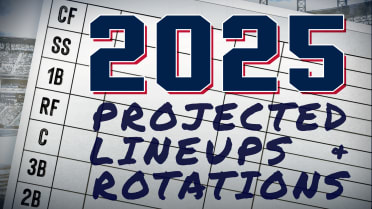The 'Ball 5' chant is the best home-field advantage in baseball
When pitching against Texas A&M can turn into a nightmare

Konnor Pilkington knew it was coming.
The Mississippi State pitcher had seen all the viral video clips. He'd been warned by his coaches and teammates. He'd heard horror stories. He'd hoped, he'd prayed, that it wouldn't happen to him.
"Oh yeah, they're known for that," Pilkington, now in the D-backs organization, told me in a call. "That's just one of those things they're known for at Texas A&M baseball. You try not to think about it because you don't wanna be put in that situation. But I walked right into it."
With runners on second and third, Pilkington fell behind two balls and zero strikes to the batter at the plate. His manager motioned for him to throw two more balls and load the bases to set up a potential inning-ending double play. Sure, maybe a smart play for the team, but not so great for Pilkington.
Four straight balls meant the Aggies fans' relentless, suffocating, can't-think, can't-pitch "Ball 5" chant would begin. An unending chorus that gets louder and stronger and more ravenous as balls continue to get thrown. Like a pack of kids watching a piñata get slowly hacked away. A lonely, torturous place to be if you're the pitcher.
This version of the chant would get all the way to a mind-melting Ball 12, and then, two pitches later, end in an Aggies grand slam.
"Well dang, this kinda sucks," Pilkington remembered thinking, and you can see exactly what he experienced in the video below.
Nobody's too sure when or how the Ball 5 chant started.
Some say the early 1990s, some say the late 90s, others say it was going on in the 80s and was started by one famed heckler named George. Either way, it's mostly been the same: After four straight balls by an opposing pitcher, the Aggies fans begin chanting "Ball 5" over and over to try to induce a fifth straight ball out of the zone. They'll chant "Ball 6" after a fifth straight, "Ball 7" after a sixth straight and so on and so forth.
"I hear different things about when it started," Will Johnson, an '01 A&M alum and current broadcaster, told me over the phone. "I would say the first time I really saw it fully was in the mid-2000's, maybe '05 or '06? It feels like it's really taken off and blown up since then. But having been around here for a while, I've heard fans saying they were doing it in the late '80s into the early '90s."
Baseball really hit it big in 1989 at Texas A&M when the team went a remarkable 58-7 (17-4 in SWC play). Johnson thinks the very first, rudimentary version of Ball 5 could've happened around then.
"They were doing all sorts of antics back then," he said. "It was wild."
Johnson says every sporting event at A&M is now filled with crowd noise and some form of chanting. Whether it's basketball, football (they have designated "yell leaders"), soccer or even during other moments in baseball games. Fans sing songs during strikeouts, count the number of engines a train has when it rolls by behind Blue Bell Park, and they blow bubbles after a run scores.
But nothing, not really anything in any baseball stadium in the country, tops the chant that begins after four straight balls.
"The best of it, the best of all that stuff, of all the traditions here, is the Ball 5 chant," said Johnson, who notes Section 203 as the part of the park it generates from. "It's hypnotic. When you're broadcasting a game, you actually love it because it does the job for us. When it starts, it becomes the story of the game. How loud is this place gonna get and how high is the count gonna get. As a broadcaster, you just sit back and let the crowd and Blue Bell Park tell the story."
Johnson recalled the Pilkington moment, saying it was "just a nightmare situation." He also remembered a similarly long one during a Super Regional game against TCU.
Johnson vehemently disagrees with a mound visit during the chant. Coaches may think they can calm down their pitcher, but then the chorus is just prolonged -- louder and louder, bearing down on the pitcher's ears.
"I've always disagreed with that," Johnson laughed. "You're just making this go on and on. Just let him throw a strike. It might get barreled up but at least he's not in this cauldron of noise anymore."
"Being in that situation, a visit wouldn't get it any better," Pilkington said. "They're just on top of you, screaming and yelling."
What about in the A&M dugout? How do the players and coaches feel about Ball 5?
"Oh yeah, they love it," former legendary A&M coach Mark Johnson told me. "They can hardly wait for the next pitch to be a ball. And when it is, they come off their feet yelling, 'Yes!'"
"They look at the opposing pitcher like, 'You have no idea what you just did,'" Will Johnson said. "'Get ready for this.'"
Even opposing teams (and the pitcher who goes through it) seem to get a kick out of the chant -- especially if the game isn't a very meaningful one.
"Opponents, I see them laughing, they know what's happening," Mark Johnson said. "Their teammates will probably be teasing them on the bus ride home. They'll probably do it to him in the showers."
"Yeah, I've seen opposing pitchers have fun with it after games," Will Johnson told me. "When they get out of it and the game's over, they'll take to Twitter and say, 'That was awesome.'"
Whoever you are, it's hard to not smile watching one of the Ball 5 viral clips. A choreographed sound that's so unique and rare and fun to hear inside a baseball stadium.
And it's also a giant home-field advantage for the Aggies -- who, despite not yet having an NCAA title, have been a powerhouse in college baseball for decades. They have more wins than any other SEC school. They've spent most of 2024 as the No. 1 team in the country, just slipping to No. 3 after two losses to LSU over the weekend.
Pilkington is right there with some of those opposing pitchers who went through a Ball 5 experience and came out the other side impressed, calling it "electric." And for a guy who's pitched at the top level in the sport in some of the biggest, most famous ballparks around, he said nothing rivals it.
"I threw two innings in 2022 at Yankee Stadium," Pilkington told me. "And that place is incredible. But I still don't think -- just imagine Yankee Stadium doing a ball count like that? I don't know how many Texas A&M put in their ballpark but it felt like as many as Yankee Stadium holds."
When you make 7,000 feel like 50,000, you know you're doing something right.
Matt Monagan is a writer for MLB.com.




